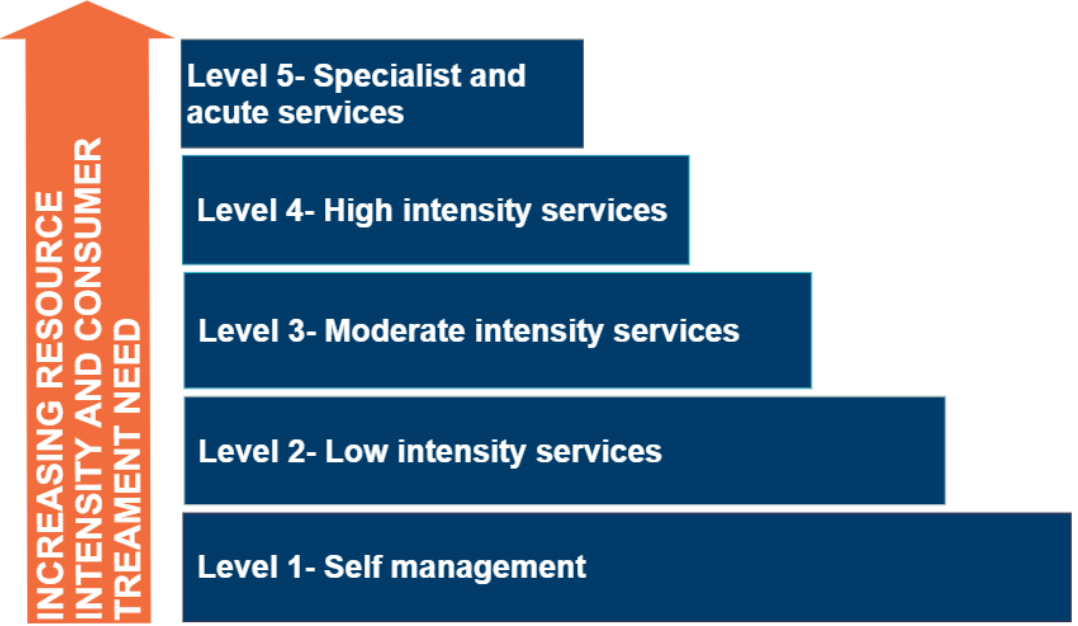Overview
This section provides a description of the different levels of care. The information gathered through the initial assessment is used to assign a level of care and inform a referral decision. The levels of care are not intended to replace individualised assessment and care - rather to provide information to guide decision making.
PRACTICE POINT - A NOTE ABOUT CONSUMER CHOICE AND PREFERENCE
There is strong evidence to indicate that when a consumer works in partnership with a trusted health care professional and is involved in making decisions about their care and selection of the service of ‘best fit’, they are less likely to drop-out of care, and more likely to experience positive outcomes (reference). World class health care considers the choices and preferences of the individual. In a stepped care model, the individual should be given a choice within “steps” or within a level of care (e.g., the consumer may have a strong preference for telephone-based psychological interventions rather than face-to-face). A choice across “steps” or levels of care is not always practical or necessary (e.g., if the consumer does not require higher intensity supports) and this can often be resolved using supported decision-making strategies.
Supported decision-making strategies for initial assessment and referral:
Make sure the consumer is provided with information using their preferred way of receiving information (e.g., written/verbal/visual, English/other language, with/without a support person).
Make sure the consumer is provided with a list of recommended intervention options (including the option of no intervention) and encourage the consumer to contribute their own options, ideas, solutions, and expectations. This might include interventions such as culturally relevant activities, or self-care strategies.
Ensure the consumer can express any concerns or fears about the options (e.g., cost, travel, previous positive or negative experiences).
Be prepared to talk about the pros and cons of each option (e.g., intensity, intervention length and commitment required, waiting periods, potential impact on symptoms).
Check in, to ensure the consumer has understood the information provided and ensure enough time for any questions from the consumer (or carer/family member).
Support the decision of the consumer, acknowledging that other options can be explored in the future if this decision does not work out.
For more information and advice about supported decision-making visit: https://healthtalkaustralia.org/supported-decision-making/overview/
Mental health services in Australia represent a complex array of service types, ranging from population-level services available to all on the internet through to highly specialised services that include short and long-term hospital care.
Grouping these into ‘levels’ is aimed at describing a continuum of services based on levels of resource intensity. This is not intended to imply that there is natural division of service types into tiered categories. While some services are associated with a single level of care, most will appear in multiple categories. For example, GP mental health care can be associated with lower levels of care when it is provided in isolation, or higher levels when delivered in combination with other services or interventions (e.g., psychiatrist or involvement of a multidisciplinary team).
The levels therefore are best thought of as combinations of interventions that form potential ‘packages’ for people requiring that level of care. The levels are differentiated by the amount and scope of resources available. A given individual may use some or all interventions described at that level and move between levels of care as required.
The core services and additional supports listed within each level of care include intervention options generally available within the mental health sector more broadly. The core services and additional supports do not represent PHN-only commissioned services. In any region, the core services and additional supports may be available through a variety of funding sources and providers.
Five levels of care are summarised in Fig. 1 below.

Fig. 1 Schematic representation of levels of care
Primary mental health care falls into Levels 1 to 4
Level 1 (self-management) is suggested for people with relatively minor problems on the Primary Domains. Contraindications to Level 1 care include problems with engagement/motivation (because these will work against any referral to self-management strategies) and severe problems in treatment/recovery history or very severe environmental stressors.
Level 2 (low intensity interventions) is targeted at people with mild problems in the primary domains, where these do not present in the context of significant problems on the contextual domains. Level 2 may also be suitable for people with moderate symptoms, but this is dependent on the extent of presenting problems on other primary and contextual domains.
Level 3 (moderate intensity interventions) is targeted at people with mild to moderate symptoms/distress where these present in the context of significant problems on other domains. Level 3 is also proposed as suitable for management of severe symptoms where no significant problems are present on other primary domains.
Level 4 (high intensity interventions) is targeted to individuals with severe symptoms/distress, where these occur in the context of significant other problems (up to severe levels). Level 4 is not suitable for people with severe symptoms who present with very severe problems on either risk or functioning. Individuals referred with this array of presenting problems are suggested as best referred to Level 5 care.
Referral Criteria to Levels of Care
Suggested referral criteria for each of the Levels are outlined in descriptions of levels of care that follow. These are based on the initial assessment of each of the domains. As the domains are interactive (in that each of the assessment factors can interact with judgements on other domains) there is considerable complexity in the possible combinations. The suggested referral criteria aim to simplify the approach by focusing only on the main patterns of presenting problems likely to be found in primary mental health care.
It is important to emphasise that the proposed referral criteria are offered only to guide judgements about the likely best treatment option. Each presenting individual will have unique requirements that must always take precedence in decision making.